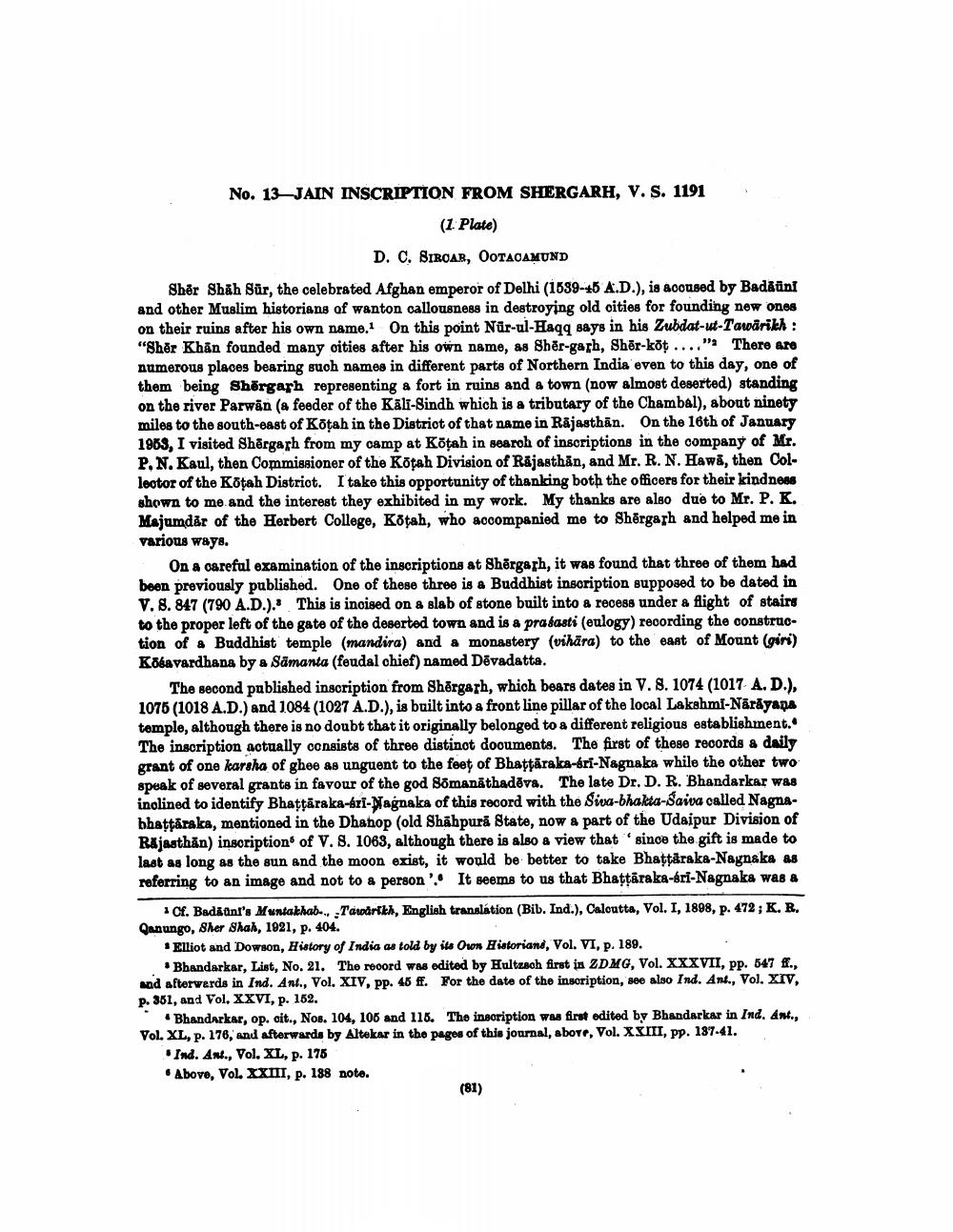________________
No. 13-JAIN INSCRIPTION FROM SHERGARH, V. S. 1191
(1. Plate)
D. C. SIRCAR, OOTACAMUND
Sher Shah Sür, the celebrated Afghan emperor of Delhi (1539-45 A.D.), is accused by Badauni and other Muslim historians of wanton callousness in destroying old cities for founding new ones on their ruins after his own name. On this point Nür-ul-Haqq says in his Zubdat-ut-Tawarikh : "Sher Khan founded many cities after his own name, as Sher-garh, Sher-kōt...." There are numerous places bearing such names in different parts of Northern India even to this day, one of them being Shergarh representing a fort in ruins and a town (now almost deserted) standing on the river Parwan (a feeder of the Kali-Sindh which is a tributary of the Chambal), about ninety miles to the south-east of Kōṭah in the District of that name in Rajasthan. On the 16th of January 1953, I visited Shergarh from my camp at Kötah in search of inscriptions in the company of Mr. P. N. Kaul, then Commissioner of the Kōtah Division of Rajasthan, and Mr. R. N. Hawa, then Collector of the Kōtah District. I take this opportunity of thanking both the officers for their kindness shown to me and the interest they exhibited in my work. My thanks are also due to Mr. P. K. Majumdar of the Herbert College, Kotah, who accompanied me to Shergarh and helped me in various ways.
On a careful examination of the inscriptions at Shergarh, it was found that three of them had been previously published. One of these three is a Buddhist inscription supposed to be dated in V. 8. 847 (790 A.D.). This is incised on a slab of stone built into a recess under a flight of stairs to the proper left of the gate of the deserted town and is a prasasti (eulogy) recording the construction of a Buddhist temple (mandira) and a monastery (vihara) to the east of Mount (giri) Kōéavardhana by a Samanta (feudal chief) named Devadatta.
The second published inscription from Shergarh, which bears dates in V. S. 1074 (1017 A. D.), 1075 (1018 A.D.) and 1084 (1027 A.D.), is built into a front line pillar of the local Lakshmi-Nārāyaṇa temple, although there is no doubt that it originally belonged to a different religious establishment. The inscription actually consists of three distinct documents. The first of these records a daily grant of one karsha of ghee as unguent to the feet of Bhattaraka-ári-Nagnaka while the other two speak of several grants in favour of the god Sōmanathadova. The late Dr. D. R. Bhandarkar was inclined to identify Bhattaraka-ári-Magnaka of this record with the Siva-bhakta-Saiva called Nagnabhaṭṭāraka, mentioned in the Dhanop (old Shahpura State, now a part of the Udaipur Division of Rajasthan) inscriptions of V. S. 1063, although there is also a view that since the gift is made to last as long as the sun and the moon exist, it would be better to take Bhattaraka-Nagnska as referring to an image and not to a person'. It seems to us that Bhaṭṭaraka-sri-Nagnaka was a
Cf. Badant's Muntakhab., Tawarikh, English translation (Bib. Ind.), Calcutta, Vol. I, 1898, p. 472; K. R. Qanungo, Sher Shah, 1921, p. 404.
Elliot and Dowson, History of India as told by its Own Historians, Vol. VI, p. 189. Bhandarkar, List, No. 21. The record was edited by Hultzsch first in ZDMG, Vol. XXXVII, pp. 547 ff., and afterwards in Ind. Ant., Vol. XIV, pp. 45 ff. For the date of the inscription, see also Ind. Ant., Vol. XIV, p. 351, and Vol. XXVI, p. 152.
Bhandarkar, op. cit., Nos. 104, 105 and 115. The inscription was first edited by Bhandarkar in Ind. Ant., Vol. XL, p. 176, and afterwards by Altekar in the pages of this journal, above, Vol. XXIII, pp. 137-41.
Ind. Ant., Vol. XL, p. 175 Above, Vol. XXIII, p. 188 note.
(81)




